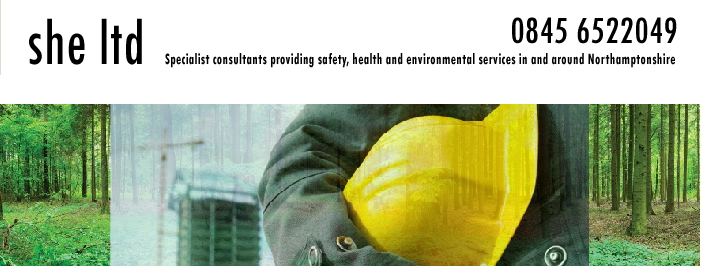Thursday 27 September 2007
Good news for safetyadviser.co.uk
For all your training needs think safetyadviser.co.uk
www.safetyadviser.co.uk
the safety sales pitch September 2007
For all your health and safety needs, from policies to risk assessmentsthink safetyadviser.co.uk big or small we aim to do it all!!!
Good news! safetyadviser.co.uk has just won the tender to provide ManualHandling and Risk Assessment training on behalf of the NorthamptonshireChamber. Watch this space for details.
So for all your training needs think safetyadviser.co.uk. Training can beorganised "inhouse" or externally. Let us know what you want.
CIEH Safety Training:
CIEH (New) Level 2 Health and Safety in the Workplace
CIEH Principles of Manual Handling
CIEH COSHH
CIEH Stress Awareness
CIEH Train the Trainer
IOSH Safety Training:
IOSH Managing Safely
Other Training:
CDM2007 Awareness
COSHH workshop
Introduction to Health & Safety workshop
Risk Management/ Risk Assessment workshop
Fire Awareness
First Aid Appointed Persons
First Aid (full 4 day course)
*workshops can be tailored to your business.
Help with environmental management systems BS8555 and ISO14001. .
CIEH Environmental Training:
CIEH Environmental Awareness training
Contact us for details.
The safety sales pitch is issued at the end of every month. It is thesales newsletter from safetyadviser.co.uk. This newsletter complements thefree information issued in the mid month newsletter "Safe Environment".
Monday 17 September 2007
safe environment September 07
In this issue:
Corporate manslaughter
Construction
Training
Corporate manslaughter
moves to the statute books
Businesses can for the first time be held criminally liable and face unlimited fines in the event of a death in their workplace. The new Corporate Manslaughter & Corporate Homicide Act 2007 comes into force in April 2008. The new act will make prosecutions for health and safety failures more straightforward. In the past it was difficult to establish the ‘directing mind’.
Want construction done safely?
The HSE have produced guidance for clients iexplaining what they need to do in construction to comply with the new CDM 2007 Regulations.
http://www.hse.gov.uk/pubns/indg411.pdf
Training
Top ten tips for good safety and environmental training
Providing safety and environmental training helps: to ensure your employees are not injured or made ill by the work they do; to develop positive safety and environmental cultures, to make safe and environmental conscious working becomes second nature to everyone; to find out how you could manage safety and the environmental better; and helps meet your legal duty to protect the health and safety of your employees and the wider environment. Here are my top ten tips on providing good training.
1.Understand what training means. Training means helping people to learn how to do something, not just telling people what they should or should not do, or simply giving them information. Training isn’t just about formal ‘classroom’ courses. Training can come in many forms. Training can be as simple as “on the job” instruction.
2.Plan your training, know your training needs; all employees need to be instructed to carry out their duties safely, with minimum of risk to the health and safety of themselves and others. Find out what those duties are. Create a simple training matrix. Look at your risk assessments, do they highlight training needs. The first step towards ensuring a safe working and clean environment is to make sure everyone working is properly trained to do their job.
3.Take into account the existing capabilities, training, knowledge and experience of workers; and ensure that the demands of the job do not exceed their ability to carry out their work without risk to themselves and others. If you think the job is to demanding or you are unsure training is required.
4.Basic training starts at induction, new recruits need basic induction training into how to work safely, including arrangements for first aid, fire and evacuation. Highlight your policies on safety and don’t forget to add a section on the environment!
5.Arrange, as considered appropriate, additional awareness information, instruction and training. This can be in the form of short “toolbox talks”, conducted monthly on the topic of the moment. Information and Instruction should be like a “dripping tap”, constant.
6.Repeat, repeat, repeat, tell them what you’re going to tell them, then tell them, then tell them what you told them. Repeat the message to help it sink in.
7.Specific attention needs to be given to those considered to be at higher risk i.e. young and inexperienced workers (highlighted in risk assessment). Tailor training to suit. Risk assessment should also highlight the need for specialist safety instruction and training. Refresher training will need to be given, as considered appropriate. For example First Aiders will need to be trained and will have refresher training every three years.
8.Get feedback on the training. Did the “student” enjoy the training; did it highlight any further needs?
9.Monitor the effectiveness of training. Conduct random inspections on working practices to see if the training is being use.
10.Get signatures, ensure all information, instruction and training is signed for!
For the most up to date information visit the safetyadviser.co.uk blog
http://safetyadviser.blogspot.com/
Kevin Jones
kevin.jones@safetyadviser.co.uk
Taking the pain out of Health + Safety at www.safetyadviser.co.uk



